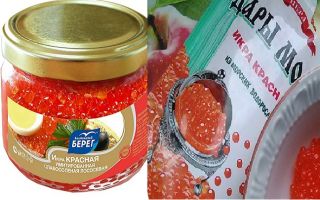Content
- 1 The history of the creation of simulated caviar
- 2 What is red imitated caviar made from?
- 3 How simulated caviar is produced
- 4 Types and appearance of simulated caviar
- 5 Is seaweed caviar good for you?
- 6 Algae caviar harm
- 7 Daily intake
- 8 How to distinguish red caviar from simulated
- 9 The use of red caviar from algae in cooking
- 10 Algae red caviar recipe at home
- 11 How to choose seaweed caviar
- 12 Storing seaweed roe
- 13 Conclusion
Artificial red caviar in some people has a strong association with rumors of a "harmful counterfeit oil". These notions are false, since in reality, red caviar is imitated from seaweed, which is so prized in Japanese cuisine for its health benefits, but it is still difficult to believe that a substitute for a famous delicacy can be not only cheap, but also healthy. It is time to expose the myths and discover the truth about the benefits and harms of seaweed caviar.
The history of the creation of simulated caviar

The production of a substitute for natural red caviar began in the 1960s in the USSR with the developments of Academician A.N. Nesmeyanov at the Institute of Organoelement Compounds of the Russian Academy of Sciences.
Healthy chicken protein served as the basis of the delicacy, which, together with champagne, was supposed to take pride of place on the New Year's table of a Soviet citizen.
The first technology, in addition to egg white, used ingredients such as vegetable oil and nutritional supplements. The protein balls of the future eggs were formed during the heating of the oil. The trial batch was named "Iskra" - from the combination of the words "artificial caviar". It was far from perfect: the eggs were hard to chew and looked little like their prototype. It was then that rumors began to spread about the "oil" origin of the product and its dangers, as a result of which a tenacious stereotype was formed, in response to which manufacturers were forced to improve the technology.
At a new stage, a gelatin component was included in the production of the product: now, for the formation of balls, denaturation of the protein in heated oil was not needed. The gelatinous analogue was more successful, since it brought the structure closer to the original, and at the same time allowed to increase the shelf life, which made production cheaper. It was in the gelatinous caviar, in addition to milk and protein supplements, that a fish product was first introduced, and then algae extracts.
The third, "non-protein" stage in the development of the technology for the production of simulated caviar has completely abandoned egg ingredients in favor of beneficial algae and inclusions of valuable fish products.
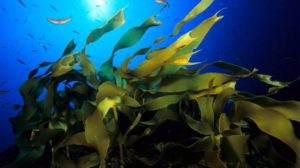
What is red imitated caviar made from?
Today, healthy caviar is made from a composition that includes gelling agents with extracts of seaweed: brown sodium alginate and red agar.
The source of raw materials is kelp, or "seaweed", which is so useful in its properties that it has found its place on the shelves of pharmacies and in recipes of traditional medicine.
In the new technology, the uniquely beneficial component of kelp not only acts as an organic marine ingredient, but also acts as a thickener that helps to achieve the consistency of real red caviar. Another plus in the collection of useful features of the product is its low calorie content.
The red color is given by natural coloring components: paprika extract - for an analogue of red caviar and vegetable charcoal - for a black version. Cheap product options may include synthetic color additives.
Healthy sea fish meat, broth with spices and fat are used as the flavor-forming ingredient, which give the product its flavor and aroma. Adding the finishing touches: natural regulators - sodium sorbate and benzoate, vegetable oil, as well as lactic and citric acid, complete the process of making seaweed caviar.
How simulated caviar is produced
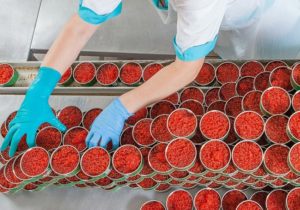
There are three main technologies for the production of simulated red and black caviar from seafood:
Protein... A watery oil emulsion is introduced into the protein mixture, from which it is further formed into eggs in a hot shop, after which the product is pasteurized in a container.
Gelatinous... Here, the protein mixture is already combined with gelatin, and then injected into the cooled to a temperature of 5 - 15 aboutWith vegetable oil in a columnar installation. The taste is formed by the minced fish. The finished product is packed in cans, sealed and pasteurized.
Algae based... Dry kelp are ground into powder, passed through a sieve and immersed in water with the addition of citric acid, flavors and aromatic additives, everything is kept until a gelling substance is formed. It is then directed into a showerhead-like press, which squeezes out the eggs through the holes, which roll into the enveloping solution. Then a cycle of drying, washing and filtration procedures is carried out until caviar pearls of the same size are obtained. The process is completed by adding a stabilizer, pH control and pasteurization.
Types and appearance of simulated caviar
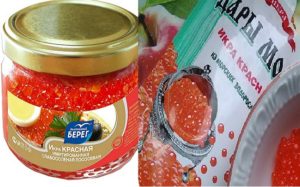
The variety of useful simulated sea caviar is distinguished by the characteristics of raw materials, recipes and manufacturing methods.
There are 2 obvious differences:
- based on fish oil;
- from seaweed.
A characteristic feature of the first is that it mimics the natural one as accurately as possible: both in taste and in the presence of the "eye of the embryos", which are kept by an uncrushed droplet. The only thing that can give an artificial origin is the absence of a watery mark after a long lying on a plate, which usually leaves an original salmon product.
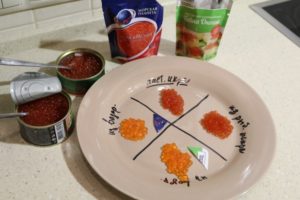
The simulated seaweed caviar has the specific taste of kelp and fish. The artificial product has a uniformly colored structure with yellowish balls, which clearly distinguishes them from the original. The eggs are stiffer to the touch, springy in properties, resembling a gelatinous consistency and slipping away when squeezed with your fingers. They do not have “eyes” characteristic of real caviar.
Is seaweed caviar good for you?
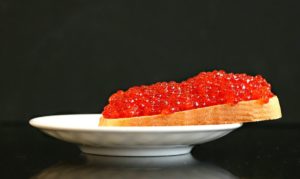
Seaweed in the composition of imitated red caviar provides a unique wealth of useful elements: first of all, iodine and bromine, as well as iron, phosphorus, potassium, magnesium, calcium.
All properties in the complex are valuable because they contribute to:
- increased immunity;
- normalization of glucose and cholesterol in the blood;
- cleansing the body of toxins and heavy metals;
- normalization of the thyroid gland;
- and even confronting cell cancerous lesions.
The high content of fish oil helps to saturate the body with the benefits of vitamins A and D:
- strengthen teeth, hair and nails;
- improve skin condition;
- contribute to the normalization of the nervous system.
In addition, fish oil in artificial red caviar as a source of Omega-3 fatty acid benefits:
- to strengthen blood vessels;
- normalization of hormonal levels against the background of stimulating the production of serotonin;
- as a powerful antioxidant capable of working with inflammatory processes and participating in the treatment of cancer.
Due to its gelatinous properties and low calorie content, seaweed caviar can be used with benefit:
- with obesity;
- on a diet and fasting days.
Alginic acid in the product has a positive effect on the digestive tract.
Algae caviar harm
All the benefits of red caviar from algae with excessive enthusiasm for seafood can turn into harm, which can manifest itself:
- disorders of the digestive system: gas or diarrhea;
- violation of the water-salt balance - due to the increased salt content in the product;
- allergy to the product, manifested by a rash, irritation and itching of the skin - due to the action of citric and lactic acids.
Daily intake
Experts recommend 50-60 g of product per day as a norm, which corresponds to 1 teaspoon. The nutritional properties of such a portion will be pleasantly pleasing - only 7 kcal, which will not need to be specially "burned".
How to distinguish red caviar from simulated
The salmon original from the artificial analogue is easy to distinguish, and above all, in appearance: seaweed caviar has a lighter shade. Its taste also differs from the original salmon product.
The same cannot be said about fish oil-based caviar: in terms of properties, it is almost identical to natural, even has plasticity, which allows you to feel the eggs bursting in your mouth.
The video shows the main ways to distinguish the original caviar from artificial protein, one of which is to use hot water.
Several balls are dipped into a mug of boiling water: the original salmon product will brighten, but not lose its structure.
The use of red caviar from algae in cooking
The advantages of sea red seaweed caviar include its properties not to stain nearby products, and also not to lose its shape: thanks to this, it is used in ensembles of cold snacks.
The classic solution is sandwich options, as well as tartlets with cottage cheese and melted cheese, which can be stacked in layers and sprinkled with herbs.
Agar's properties of maintaining structure at high temperatures even make it possible to add healthy seaweed roe to dough for baking snacks.
It should also be added that in the light of modern culinary trends, alginic caviar has ceased to be just an imitation of red caviar of valuable fish: the developing molecular gastronomy has brought the technology of the production of simulated caviar from algae to a new, independent level, at which it is gradually disassociated with the salmon product. Thus, the unique properties of sodium alginate even make it possible to create "caviar" from alcohol, which cannot be obtained with the help of gelatin due to the destruction of its molecules by alcohol.
Technologies based on seaweed extracts, initially created to make expensive food more affordable, have become a part of the haute cuisine recipe promoted by trendy luxury restaurants.
Algae red caviar recipe at home
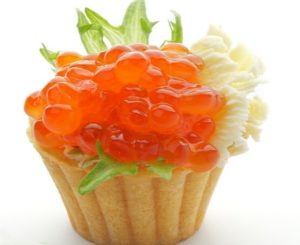
A simple recipe will help you make healthy simulated seaweed caviar.
You need to take:
- Nori algae leaves - 7 pcs .;
- carrots - 1 pc.;
- beets - 1 pc.;
- agar - 1 g;
- vegetable, odorless, oil - 2 glasses;
- salt - 1 tsp;
- drinking water - ½ glass.
Cooking process:
- Juice is extracted from vegetables, which is then filtered through a fine sieve or layers of gauze.
- Cool the oil.
- Mix agar with 2 tbsp. l. the mixture is kept for 15 minutes.
- Pour Nori with water (0.5 l), add the carrot and beet cake remaining after squeezing the juice. Warm up for about 5 minutes. The mixture is filtered.
- Then add vegetable juice until a natural red hue is obtained.
- Add agar, salt and boil. Cool the solution and pour it into a plastic bag with a hole in the corner or into a culinary syringe.
- In turn, the balls of future eggs are squeezed out with a syringe into chilled oil in a container convenient for this process.
- After the first balls harden in oil, they are transferred to a plastic container and sent to the freezer so that the eggs "grab". Then the process is repeated until the end of the mixture.
How to choose seaweed caviar
Simulated seaweed red caviar is available at retail in glass jars or soft plastic packaging.
The main rules to consider when choosing a healthy marine product:
- The can or packaging must be free from external defects;
- The container must stand on the shelf of the refrigerator, be marked with TU or GOST, information on the expiration date.
- The composition data on the label should be checked: the product must not contain artificial colors;
- It is better if the container is transparent - so you can see how the contents look and what their consistency is. Ideally, the eggs should be regular in shape and not “float” in liquid. It is true, however, that simulated seaweed caviar is also perfectly stored in polyethylene, so if the shelf life is observed and the soft packaging is in good condition (no bulges and voids), you can save on the can.
- You should not buy caviar in the so-called butter cream: the production technology of such a product includes artificial additives and threatens the harm of exacerbations in case of gastrointestinal diseases.
Storing seaweed roe
Seaweed caviar in an airtight state should be stored only in the refrigerator, focusing on the period indicated on the package. An open sea product must be consumed quickly: the beneficial properties will last up to 12 hours.
Conclusion
Summing up the excursion into the world of production of imitation of a valuable delicacy, we can conclude that the benefits and harms of seaweed caviar are determined mainly by the compliance of the product with technological standards. According to the idea of the technologists, the simulated caviar should be a high-quality natural fake: as a result, harmful synthetic dyes will be absent in it, and vice versa, all the useful properties of kelp are fully revealed.

